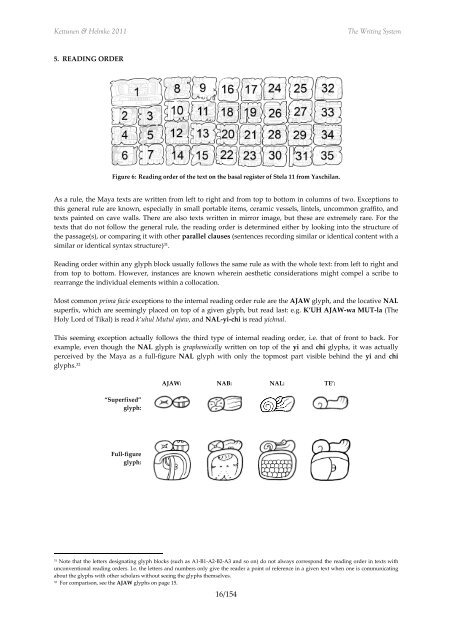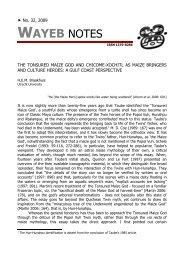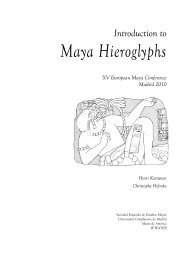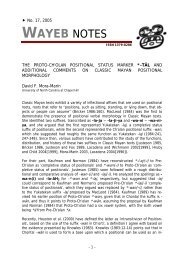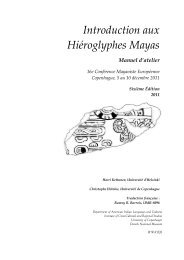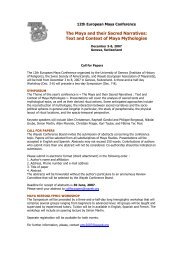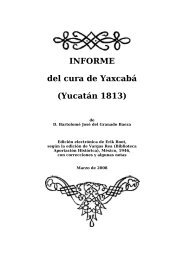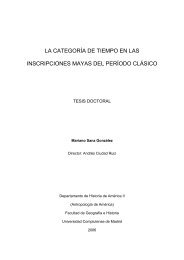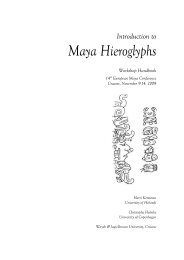Introduction to Maya Hieroglyphs - Wayeb
Introduction to Maya Hieroglyphs - Wayeb
Introduction to Maya Hieroglyphs - Wayeb
Create successful ePaper yourself
Turn your PDF publications into a flip-book with our unique Google optimized e-Paper software.
Kettunen & Helmke 2011<br />
The Writing System<br />
5. READING ORDERR<br />
Figure 6: Reading order of the text on the basal register of Stela<br />
11 from Yaxchilan.<br />
As a rule, the <strong>Maya</strong> texts are written<br />
from left <strong>to</strong> right and from <strong>to</strong>p <strong>to</strong> bot<strong>to</strong>m in columns of two. Exceptions <strong>to</strong><br />
this general rule are known, especially in small portable items, ceramic vessels, lintels, uncommon graffi<strong>to</strong>, and<br />
texts painted on cave walls. There are also texts written in mirror image, but these are extremely rare. For the<br />
texts thatt do not follow<br />
the general rule, the reading order is determined either by looking in<strong>to</strong> the structure of<br />
the passage(s), or comparing it with other parallell clauses (sentences recording similar or identical content with a<br />
similar or<br />
identical syntax structure)<br />
31 .<br />
Reading order within any glyph block usually follows the same<br />
rule as with the whole text: from left <strong>to</strong><br />
right and<br />
from <strong>to</strong>p <strong>to</strong> bot<strong>to</strong>m. However, instances are known wherein aesthetic considerations might compel a scribe <strong>to</strong><br />
rearrangee the individual elements within a collocation.<br />
Most common prima facie exceptions<br />
<strong>to</strong> the internal reading order rule are the<br />
AJAW glyph, and the locative NAL<br />
superfix, which are seemingly placed on <strong>to</strong>p of a given glyph,<br />
but read last: e.g. K’UH AJAW-wa MUT-la (The<br />
Holy Lord of Tikal) is read k’uhul Mutul ajaw, and NAL-yi-chi is<br />
read yichnal.<br />
This seeming exception actually follows the third type of internal reading order, i.e. that of front <strong>to</strong> back. For<br />
example, even thoughh the NAL glyph is graphemically written<br />
on <strong>to</strong>p of the yi and chi glyphs, it was actually<br />
perceived<br />
by the <strong>Maya</strong> as a full-figure NAL glyph with only<br />
the <strong>to</strong>pmost part visible behind the yi and chi<br />
glyphs. 32<br />
AJAW:<br />
NAB:<br />
NAL:<br />
TE’:<br />
“Superfixed”<br />
glyph:<br />
Full-figure<br />
glyph:<br />
31<br />
Note that the letters designating glyph blocks (such as A1-B1-A2-B2-A3 and so on) do not always correspond the reading order in texts with<br />
unconventional reading orders. I.e. the letters and numbers only give the readerr a point of reference in a given text when one is communicating<br />
about the glyphs with other scholars without seeing the glyphs themselves.<br />
32<br />
For comparison, see the AJAW glyphs on page 15.<br />
16/154


